- Why Does Grazing Alter Plant Composition?
- Root Carbohydrate Storage
- Rooting Depth
- Shading
- Treading
- Nutrient Distribution
- Summary
Much attention has been placed on the potential negative environmental impacts of grazing; however, grazing can be a powerful tool for improving pasture health and productivity. This has been realized for many years. In fact, Aldo Leopold listed the ax, plow, cow, fire and seeding as potential renovation tools in the early 1900s. These tools have changed little over the years and are as effective today as in the early 20th century. Grazing diminishes the competitive ability of plants like broomsedge and johnsongrass and improves the competitiveness of bermudagrass, bahiagrass and even clovers. Improper grazing, on the other hand, can decrease the competitiveness of desirable species like orchardgrass or switchgrass and encourage undesirable weedy species.
Why Does Grazing Alter Plant Composition?
Defoliation can be an effective herbicide and can be segregated into two types: non-selective and selective. An obvious example of non-selective defoliation is mowing or "bush hogging," since all plants are clipped to the same height. Taking advantage of animals' selective grazing greatly increases the effectiveness of defoliation by "mowing" only certain plants. Repeated removal of top growth of preferred "weeds" like johnsongrass can provide a more effective and selective control than mowing. A dramatic example of the effectiveness of selective grazing involves goats. These animals prefer browse and many weeds like honey-suckle, blackberry and curly dock and can completely remove some broadleaf species from continuously grazed areas while ungrazed grass species thrive (Figure 1).
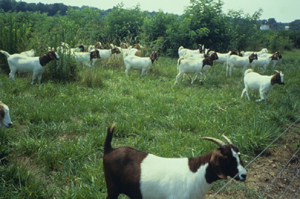 Figure 1. Goats prefer high quality browse like honeysuckle, briars and other weedy species and, over time, can completely eliminate them from pastures.
Figure 1. Goats prefer high quality browse like honeysuckle, briars and other weedy species and, over time, can completely eliminate them from pastures.Why does uniform or non-selective grazing discourage growth of some plant species and encourage growth of others? In other words, why are some plants more tolerant of grazing than others? The answer to this question depends on plant species and is not easy to answer. Possible reasons include (1) differential root storage of carbohydrates, (2) altered rooting depth, (3) improved light penetration (4) higher tolerance to treading or (4) redistribution of nutrients from grazing.
Root Carbohydrate Storage
Carbohydrates stored in roots are the "savings account" of many forage plants. They are energy stores used for winter survival and regrowth after defoliation. Plants species differ in root storage characteristics. For example, bahiagrass has large rhizomes (Figure 2) that store large amounts of carbohydrates for regrowth. These energy stores are quickly replenished because bahiagrass has a low growth habit and leaves are located close to the ground. Johnsongrass also has large rhizomes to store carbohydrates, but when defoliated use most of this stored energy to produce large upright leaves. Under continuous grazing, cattle typically select johnsongrass over bermudagrass and constantly remove regrowth. This frequent leaf removal does not allow root reserves to replenish. With continuous "withdrawals" from the carbohydrate savings account to produce new leaves and no "deposits" the plant eventually runs out of energy and dies.
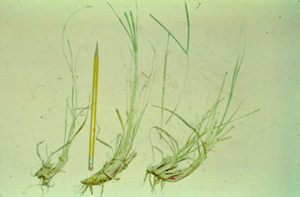 Figure 2. Photo showing carbohydrate-containing rhizomes of bahiagrass that provide energy for regrowth after grazing.
Figure 2. Photo showing carbohydrate-containing rhizomes of bahiagrass that provide energy for regrowth after grazing.Broomsedge is also sensitive to frequent defoliation, particularly in early spring when new growth is palatable to grazing animals. Heavy spring grazing can penalize broomsedge in pastures and favor growth of grazing-tolerant grasses like bermudagrass. Of course, soil pH and nutrients must also be adequate for growth of these more productive forages. Why doesn't haying or mowing kill broomsedge or johnsongrass? The reason is simple -- plants have ample time to replenish root carbohydrates in the period between cuttings.
Rooting Depth
Overgrazing also affects root depth and in turn decreases competitiveness for water. Plants that are grazed preferentially and continuously for long periods of time will likely have shallower root systems than ungrazed plants. This gives ungrazed plants an advantage in rooting depth and may, over time, alter the composition of plant species in a pasture.
While studies that examine the direct effects of grazing on rooting depth are difficult to find, consider the common "understocked and overgrazed" scenario observed in bermudagrass pastures. Spot grazing of bermudagrass in understocked continuously grazed bahiagrass/bermudagrass pastures can shift the balance of plant species toward bahiagrass or other less palatable species. This is because the areas of heavily grazed bermudagrass are at a competitive disadvantage. Another excellent example is when smutgrass is not defoliated in bermudagrass or bahiagrass pastures (Figure 3). Non-grazed areas of bermudagrass, bahiagrass and smutgrass are busy converting sunlight to plant carbohydrates and thrive and expand. Intensive grazing management or frequent mowing can help bermudagrass compete with other plants by forcing cattle to equally graze all species present in the pasture.
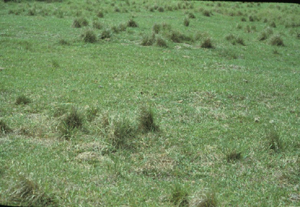 Figure 3. A closely grazed bahiagrass pasture. Note that smutgrass has not been consumed by cattle and likely has a competitive advantage for light and water.
Figure 3. A closely grazed bahiagrass pasture. Note that smutgrass has not been consumed by cattle and likely has a competitive advantage for light and water.Shading
Most people think of trees when effects of shading are mentioned; however, shading also occurs in under-grazed pastures. Light availability is critical to the survival and competitiveness of many forage species. Light is the energy that fuels the plant factory.
The prostrate leaves of legumes and forbs intercept sunlight and can shade out lower growing grasses and seedlings. The upright growth habit and broad leaves of red clover, alfalfa and chicory can shade out even aggressive species like bermudagrass if fields are not defoliated often. Conversely, low growing white clover can be sensitive to shading in undergrazed tall fescue and bermudagrass since little light will reach the ground level where it is needed by clover.
In some situations light availability can improve competitiveness of clovers (Figure 4). White clover is able to regrow rapidly from ground level buds and intercept large amounts of light with flat broad leaves. This allows certain types of white clover to dominate closely grazed tall fescue pastures. There are several other instances where grazing, mowing or burning can "release" light to lower portions of the canopy and improve plant performance and persistence.
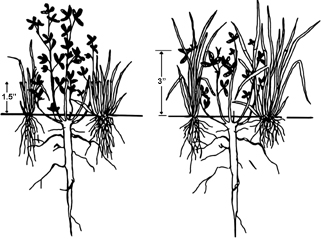 Figure 4. Diagram depicting effects of grazing pastures to 1.5 inch stubble height (left) versus 3 inch stubble height (right) on grass and clover regrowth. From Blaser et al., 1986, Virginia Polytechnic Institute. Bulletin 86-7.
Figure 4. Diagram depicting effects of grazing pastures to 1.5 inch stubble height (left) versus 3 inch stubble height (right) on grass and clover regrowth. From Blaser et al., 1986, Virginia Polytechnic Institute. Bulletin 86-7.Another practical example of shading occurs in dormant bermudagrass or bahiagrass pastures that are overseeded with winter annuals. Rye, wheat, oats, ryegrass, arrowleaf clover and crimson clover are all sensitive to low light levels. Closely grazing residual bermudagrass or bahiagrass to a 1-2 inch height before planting winter annuals increases the light available to seedlings and improves fall and early spring forage production (Figure 5).
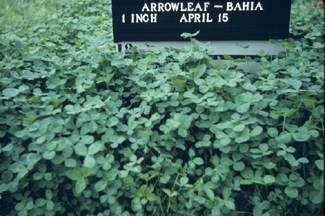 Figure 5. Spring arrowleaf production on bahiagrass overseeded with 6 inches of residue (bottom) and 1 inch of residue (top) in the fall. Excess residue shaded seedlings and negatively affected establishment and growth while arrowleaf clover overseeded on 1 inch of residue had 12 inches of growth.
Figure 5. Spring arrowleaf production on bahiagrass overseeded with 6 inches of residue (bottom) and 1 inch of residue (top) in the fall. Excess residue shaded seedlings and negatively affected establishment and growth while arrowleaf clover overseeded on 1 inch of residue had 12 inches of growth.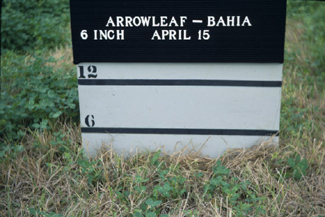
Other management practices can alter light relationships. Burning bermudagrass hayfields in early spring removes thatch, exposes soil to light, and hastens greenup. Thatch removal from burning or grazing exposes stolons to light and increases leaf density of bermudagrass fields.
Grazing and light also increases growing points present on the lower portions of plants and can improve regrowth rates. In a central Alabama study in which arrowleaf clover was harvested twice a week to simulate grazing, a significant number of buds remained below "grazing" height. Arrowleaf clover allowed to grow unharvested had many more buds in the upper portion of the canopy where sunlight was available. Growing points near ground level on the harvested arrowleaf clover allowed rapid regrowth following harvest and would likely sustain forage growth longer in the spring than unclipped arrowleaf clover (Figure 6). Harvesting tall fescue for hay at the proper maturity (boot to soft dough stage) also exposes lower portions of the plant to light and encourages rapid tillering and regrowth. Timely grazing or mechanical harvest removes older, lower quality, less efficient leaves and improves overall forage regrowth potential and quality.
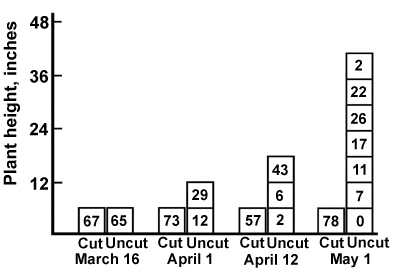 Figure 6. Distribution of buds per square foot by 6-inch height intervals on Yuchi arrowleaf clover cut every two weeks, or uncut. (From Southern Forages, 2nd Edition. Adapted from original data of Hoveland, et al., 1972.
Figure 6. Distribution of buds per square foot by 6-inch height intervals on Yuchi arrowleaf clover cut every two weeks, or uncut. (From Southern Forages, 2nd Edition. Adapted from original data of Hoveland, et al., 1972.Treading
Animals can also directly alter pasture composition through hoof action or treading. Many grasses are more tolerant of treading than others. For example, sod forming species like bermudagrass or bahiagrass are highly tolerant to treading damage while bunchgrasses like orchardgrass typically have lower tolerance. Legumes are normally less tolerant to treading than grasses.
Crown forming legumes like alfalfa and red clover generally have less treading tolerance than white clover. Because legumes are more sensitive to treading damage, species composition of pastures can shift toward grasses, particularly under heaving "pugging" conditions. Damage from treading is typically higher on heavy clay soils and is greatly increased under high soil moisture conditions, regardless of soil type.
Nutrient Distribution
Pasture composition can also be altered by nutrients returned in animal excreta. Dung (high phosphorous content) and urine (high nitrogen content) stimulate growth of clover or grass respectively. In an experiment where sheep grazed a mixture of white clover and perennial ryegrass, returning urine and dung to pastures increased overall forage production by more than 20 percent (Figure 7). Note that excreta return did not effect the growth of ryegrass or white clover equally. Ryegrass production in the pasture roughly doubled when urine and dung were returned while white clover production decreased.
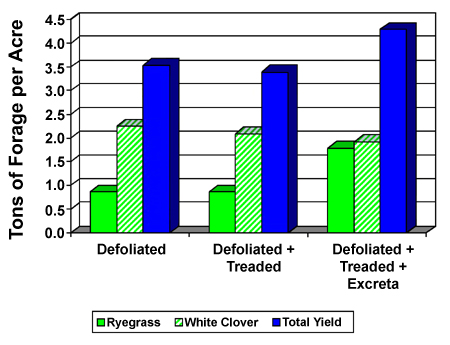 Figure 7. Effect of defoliation, treading and excreta return to pastures on yield of perennial ryegrass and white clover pastures stocked at 10 sheep per acre. (Adapted from Currl and Wilkins, 1981.)
Figure 7. Effect of defoliation, treading and excreta return to pastures on yield of perennial ryegrass and white clover pastures stocked at 10 sheep per acre. (Adapted from Currl and Wilkins, 1981.)While it is difficult to influence the quantity of dung and urine that animals return to pastures, it is possible to alter the distribution of these nutrients. In continuously grazed pastures, high concentrations of nutrients are typically deposited near water or shade where animals congregate. A study examining the effects of grazing intensity on nutrient distribution was recently conducted by the University of Missouri. In this study, increasing the number of paddocks in a rotational system improved manure distribution and decreased the amount of time required to deposit one manure pile per square yard of pasture from 27 years to 2 years (Table 1).
| Table 1. The effect of grazing intensity on manure distribution in pastures. | ||
|---|---|---|
| Number of Paddocks | Rotation Frequency | Years to get 1 pile/sq. yard |
| 1 | Continuous | 27 |
| 3 | 14-day | 8 |
| 12 | 4-day | 4-5 |
| 24 | 2-day | 2 |
| - | ||
| Lory and Kallenbach, 2002, Missouri Grazing Manual. | ||
Summary
While concepts above appear simple, remember that balance must be achieved between light, forage quality, root carbohydrate reserves, treading, and nutrient distribution to improve the plant and animal performance from various forage species. Awareness of these concepts should help graziers assess the impacts of certain grazing practices for their farms. No "one size fits all" solution exists for all farms.
Animals can be an effective and economical pasture renovator. Some useful examples appear below.
- In winter and early spring months allow animals to graze high quality annual weeds like chickweed or little barley to decrease weed pressure.
- Modifying fertility and grazing timing can reduce species like johnsongrass and broomsedge in pastures without chemicals or plows.
- Improving grazing management with rotational stocking can improve persistence and productivity of desirable plant species.
- Use grazing pressure to suppress grass growth and favor clover establishment and persistence.
- Defoliate bermudagrass with rotational stocking to improve utilization, remove old growth, and provide lush high quality regrowth.
Overall farm management can be improved if producers view pastures from the plant perspective when animals are grazed. This perspective encourages the implementation of sound grazing management practices and improves both animal and plant performance.
1Crop and Soil Science Department
Status and Revision History
Published on Jan 28, 2004
Published on Mar 24, 2009
Published with Full Review on Mar 30, 2012
Published with Full Review on Jan 30, 2017


























































